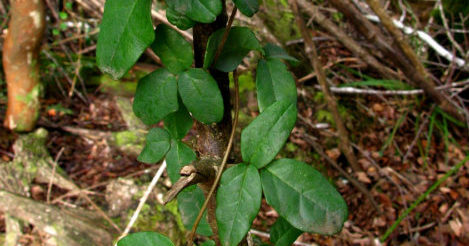
 )
)Despite being a biologist, I’ll admit that I’ve neglected plant biology relative to some other areas. As a student of molecular and microbiology, I suppose I’ve not paid as much attention to macroscopic organisms in general, but one picks up a certain amount of animal biology because it is similar to human biology. And the kinds of evolutionary biology conversations that come up in Christian circles often focus on animal evolution, presumably because animals are familiar and because human evolution is the most questioned. In any event, as I mentioned a couple of weeks ago, the sci-fi novel Semiosis introduced me to some features of actual plant biology I hadn’t appreciated. So the recent English translation of Stefano Mancuso’s The Revolutionary Genius of Plants: A New Understanding of Plant Intelligence and Behavior seemed like a good opportunity to delve more into the science behind the story. And boy was I not disappointed. There’s so much interesting material here that I think it’s worth unpacking over a couple of weeks.
A few overall highlights: For one, it is a gorgeous book with plenty of full color photographs. If something like Programming the Universe is too abstract and esoteric for you, with its discussion of quantum physics and computation, the visual richness of this book and its more tangible subject matter may be more to your liking. For another, Mancuso has a lot to say about the uniqueness of plants, how they can expand our understanding of life, and how the features of plants can be harnessed to address challenges faced by humans. Some applications are conceptually straightforward, like the plant-inspired Warka Water solution for extracting moisture from the air to provide water in desert environments (mentioned previously on the blog). Others get a bit more philosophical (more as we go). The ideas are plentiful; the only disappointment might be that the book leaves you wanting more. The 200 pages go by quickly, even with time to linger on the double-page illustrations.
The central thesis is that plants are underappreciated because in so many ways, plants zig where animals zag; consequently, we don’t even recognize that plants are capable of the same functions as animals because the way they go about them is so different. It’s even in our figures of speech; zig-zagging is an animal behavior. One of the most striking examples of something plants can do in a very different way is sight. Admittedly, the ability of plants to see is still be explored, and perhaps a different explanation of the evidence will emerge. Still, in chapter 3 Mancuso tells us about the Boquila trifoliolata, a ground-rooted vine that can reshape its leaves to blend in with those of surrounding plants with remarkable versatility. After detailing why several other explanations are inadequate, he makes the case that Boquila trifoliolata knows what the neighboring leaves looks like by, well, looking at them. It doesn’t have eyes like ours, but its individual cells have structures that could allow them to perceive variations in light.

 )
)Sight without dedicated eyes is also an example of a general pattern whereby plants solve problems differently than animals. Animals tend towards specialized and localized organs for various functions. Eyes to see, ears to hear, etc. Plants tend towards distributed solutions with modular components; each cell a little self-contained eye rather than many cells operating as distinct components of a single eye. Of course, this is a generalization. Plants do have specialized tissues and structures; leaves are not roots, germination often has dedicated structures like pistils and stamens, although even then plants tend to have many of them rather than just one or two. And humans have some more distributed solutions; the immune system is more modular and less subject to single points of failure than our sight. Still, I think it is a useful generalization to reflect on, and Mancuso makes a good case that this difference has impacted our appreciation of everything that plants can do because we don’t recognize the mechanism.
Another intriguing example is the brainless memory of plants, presented in chapter 1. Here our examplar is the Mimosa pudica, a flowering plant popular for its ability to respond to touch. Its leaves will fold up rapidly when stroked or poked, then reopen after a few minutes. It has the same response to a variety of stimuli; it seems to be a defensive response. Such behavior is remarkable enough on its own, but it has also allowed us to study plant memory as well. After several repetitions of the same stimulus, Mimosa pudica plants will stop closing their leaves. They can still close up in response to other stimuli, demonstrating that they are not simply worn out. Instead, they apparently remember that they were not actually harmed by the initial, repeated stimulus and so a defensive measure is not actually required. And they can remember for 40 days or more. The advantage is clear enough; not responding when it is not necessary saves energy for when it is needed. That’s the why, but the how is less clear; so far the leading hypothesis is epigenetics–persistent changes in gene expression patterns that do not depend on changes to the sequence of the genes–but investigation is ongoing.
Hopefully that gives you a sense for the range of abilities observed in plants and how much we still have to learn about them. Next week, we will dig deeper into what Mancuso thinks we can learn from them.
Andy has worn many hats in his life. He knows this is a dreadfully clichéd notion, but since it is also literally true he uses it anyway. Among his current metaphorical hats: husband of one wife, father of two teenagers, reader of science fiction and science fact, enthusiast of contemporary symphonic music, and chief science officer. Previous metaphorical hats include: comp bio postdoc, molecular biology grad student, InterVarsity chapter president (that one came with a literal hat), music store clerk, house painter, and mosquito trapper. Among his more unique literal hats: British bobby, captain’s hats (of varying levels of authenticity) of several specific vessels, a deerstalker from 221B Baker St, and a railroad engineer’s cap. His monthly Science in Review is drawn from his weekly Science Corner posts — Wednesdays, 8am (Eastern) on the Emerging Scholars Network Blog. His book Faith across the Multiverse is available from Hendrickson.

nice information provided
we are conducting a conference on plant science and molecular biology conference in Auckland
https://world.plantscienceconferences.com/